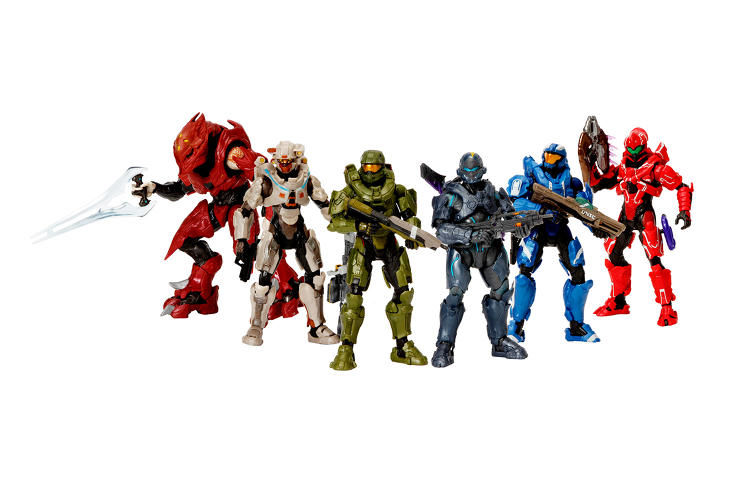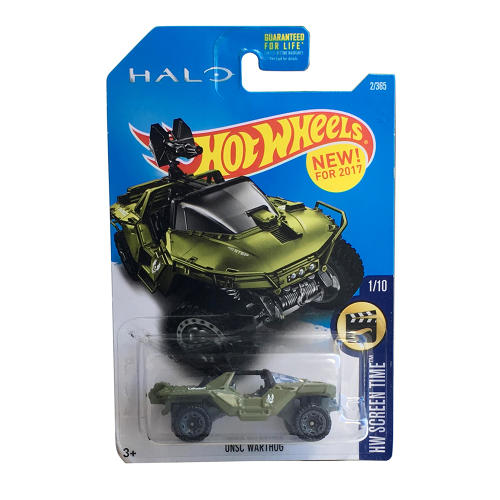How Halo Aims To Grow Beyond Its Gaming Roots
When Bonnie Ross became Microsoft’s head of all things Halo nine years ago, she wasn’t just thinking about video games.
Ross wanted Halo to endure over decades, and so she studied other entertainment franchises with a geeky bent—Batman, Pokémon, Lord of the Rings, Harry Potter, and above all, Star Wars—to understand how they achieved longevity. The common thread was that they all became less dependent on their core medium for revenue.
“A lot of their initial businesses, what was the core business at the beginning, changed to a different business,” Ross says. “And a lot of it was consumer products.”
“Consumer products,” in this case, is business jargon for everything in the Halo universe besides the wildly popular video games. It includes toys, T-shirts, novels, comics, full-scale replicas, and—for lack of a better term—tchotchkes. Ross, a corporate vice president at Microsoft and the leader of Halo developer 343 Industries, oversees both the gaming and non-gaming sides of the business, which operate out of the same studio in Redmond, Washington.

In recent years, the earnings disparity between those two sides has shrunk. Since the first Halo game launched in 2001, the franchise has brought in $5 billion. Roughly 30% of that revenue, or $1.5 billion, has come from consumer products.
In an interview, Ross says the studio has looked at how to turn the non-gaming side of Halo into the larger piece of the pie.
“As we launch a game, and our game is doing well, our consumer products business rides on that coattail, so we’re not at the point where our consumer products business is leading our business,” Ross says. “But if you look at some of the biggest franchises, consumer products are where they get the lion’s share of the money.”

Merchandising, Merchandising
The idea of blockbuster entertainment franchises making most of their money on licensed products is hardly new. Last year, Fortune estimated that the Star Wars films—including home and box office sales—only accounted for about $13.05 billion of the franchise’s $41.98 billion lifetime earnings. Merchandising alone has been a bigger moneymaker than the movies, bringing in $17 billion in 1977. (Mel Brooks was right all along.)
But while media giants like Disney have demonstrated how to turn movies and comic books into merchandising powerhouses, no such blueprint exists in the gaming world. Nintendo has one of gaming’s most recognizable faces in Mario, yet only 1% of the company’s 2015 revenue came from licensing, Reuters reports. Rovio Entertainment’s Angry Birds is notorious for its glut of licensed goods, but even during its heyday four years ago, most of the money came from games. (The Angry Birds movie may tip the scales, but only because Rovio’s revenue has cratered in recent years.)
Ross envisions Halo becoming more like those blockbuster movie franchises. Even if gaming is the core business, consumer products are a broader sign of franchise strength, helping to fuel a rabid fan base in between major releases. In the past, she’s compared Halo to Star Wars, and doesn’t shy from that comparison now.
“When I look at having Star Wars as an aspirational target, it’s how we all felt the first time we saw that Star Wars movie, and how that universe, and any story you want to tell in that universe, is worth listening to,” Ross says.
In essence, consumer products aren’t just about making money. They’re about making sure people never stop thinking about Halo, even when there’s no new game to play.

Crossing Over
Keep in mind that in the broader entertainment world, Halo’s $1.5 billion lifetime consumer product revenue barely registers as a blip, says Lutz Muller, a toy industry expert who runs a consulting firm, Klosters Trading Corporation. In License Global‘s list of the top 150 licensors, which collectively reported $262.9 billion in revenue last year, Microsoft doesn’t even show up. (Microsoft counters that it chooses not to report revenues to this list, but if it did, Halo earnings alone would easily make the cut.)
“If you look at what Halo is doing, Microsoft, whatever they tell you, are not a factor in licensing merchandise, period. End of story,” Muller says.
That’s largely because of the toy business, which makes up 31% of all entertainment licensing revenue—larger than any other segment. Although Mattel has been putting out Halo-themed Mega Bloks and BoomCo toy guns, neither are top sellers for Mattel, and both toy lines are much smaller businesses than rivals LEGO and Nerf, according to Muller. Mattel is now becoming a bigger partner, with Halo action figures, remote control vehicles, and Hot Wheels coming this year and next, but it’s unclear how well they’ll sell.
The problem, Muller says, comes down to demographics. The toy business generally appeals to children between ages 2 and 10, while Halo is marketed to older teens and adults. Toy makers are more interested in pushing franchises with all-ages appeal, which explains why other game franchises, such as Destiny and Warcraft, aren’t moving a lot of toys either.
“I can’t tell you of one successful video game brand that has made the transition into toys,” Muller says.
Ross argues that the audience for Halo’s non-gaming business is starting to expand organically. Children who are a little young to be shooting aliens in the face might still get a kick out of Halo Mega Bloks. Adults who don’t enjoy virtual combat might still approach the series’ space opera plot through comics or novels. Though she doesn’t offer specifics, Ross says the company has data showing a certain level of cross-generational appeal.
“People that were playing the first Halo, they now have kids that they’re bringing into the franchise, and that’s where we see our toy business,” she says.

A Halo For Everyone
Even if Halo is carving out modest success in toys and other merchandise, it’s unlikely that these products and their corresponding games will propel the franchise to become a massive multimedia one. To reach the next level, Halo will need something new.
In Muller’s view, this would likely have to be a movie with a major marketing push behind it, because that’s what gets toy makers to activate their sales forces. “If they wanted to make it possible for toy companies and other license companies to get really interested in the brand and put some weight behind it, what I would suggest is, make a movie and make a successful one,” Muller says.
Ross points out that Halo has already expanded beyond games to live-action web video series, books, and comics. There’s also a Halo TV series for Showtime in the works, with Steven Spielberg producing. But she rejects the idea that Halo must commit itself to a blockbuster movie or de-emphasize gaming.
“Games will always be the core business for Halo,” she says. “It’s what we’ve built the brand around, and the lifeblood that connects the various pieces of the franchise.”
To that end, Ross doesn’t outright dismiss the idea of new Halo games for a wider audience. While she is very careful to note that 343 Industries doesn’t have any plans on that front, she says the studio is watching the younger demographic and figuring out how to balance their interests against those of core fans.
“Whether or not we do a game, I think we need to be really deliberate on the right game, because we can’t alienate our core audience,” Ross says. “I would say that when we first started the franchise, the thought of doing, like, a LEGO Halo game was not something that our core fans thought was interesting, whereas now we’re getting requests for that.”

Appealing To The Base
If you’re a diehard Halo fan, this talk of more merchandising and new audiences might make you squeamish. There’s certainly a faction of Star Wars fans who feel the films have been ruined by merchandising, and film buffs who believe the Star Wars business model has ruined cinema.
Ross—herself a huge Star Wars fan—is aware of the potential pitfalls.
“When you look at how the overall [Star Wars] portfolio is managed, there is a lot, a lot of stuff out there. And not all of it is on canon,” Ross says. “It’s been very important for us to have a more curated, connected story.”
She admits that 343 Industries can get carried away in this regard. In recent years, the Halo games have become overwrought with storylines, and an expectation that players have studied the lore from the expanded universe. At some point, the series’ purity of gameplay, backed by simple but cohesive plot lines, got lost.
“The learning we’re looking at right now is, How do we be a little bit more purist about the stories we tell in our games, and how do we make sure that we use our consumer products and all our novels and everything to tell the richer, deeper story?” Ross says. “Fans have definitely given us the feedback that we’ve had a little bit too much story out there.”
On the whole, though, Ross suggests that Halo’s ambitions are resulting in better games for the core audience. She describes how Greg Bear, the author of a trilogy of Halo novels, visited 343 Industries to describe his vision for the Forerunner characters that appeared in future games. And with Halo 5, the game designers were thinking about how their vehicle and weapon designs might look as toys. One might view the latter example with cynicism—another sign that merchandising is poisoning artwork—but Ross sees it as a way to prod Halo’s designers into thinking differently.
“When you look at something like Star Wars, or others, you do want to re-enact your own stories if you’re a kid. You do look at LEGOs, you do look at action figures when you tell your own stories,” Ross says. “And it really makes our team think more broadly as they design, which I think is good.”
Halo is trying to strike a tough balance. Ross wants the franchise to expand its horizons so that it might be cherished by a wider audience. But for a video game whose roots are in violent simulated combat, there’s no easy, proven way to do that. Ross and 343 Industries are in the difficult position of trying to keep fans happy—the importance of which she stresses multiple times throughout our interview—while charting entirely new territory.
“The critical piece there is to never alienate the torch bearer. And the torch bearer, if you look at Marvel or whatever, is the kid that was so into that comic book character before that comic book character ever came to the masses,” she says. “How do you give a nod to him or her as you broaden the franchise? You have to be really careful, because if you alienate the torch bearer, you lose what the DNA is of your franchise.”
A new line of Halo toys, including action figures like these, will roll out this year and next. There are also Halo T-shirts and comic books.










Fast Company , Read Full Story
(56)



